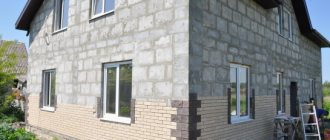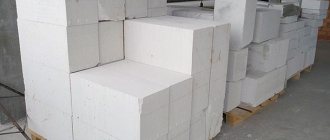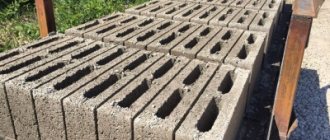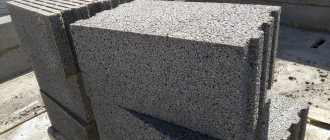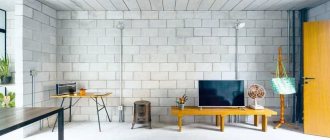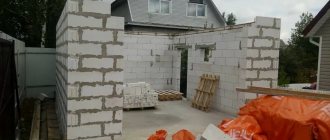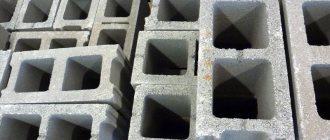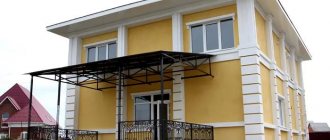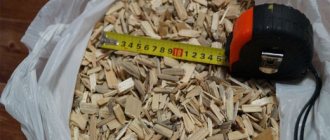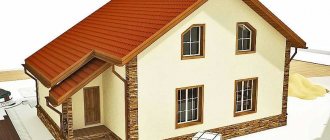When choosing a material for building a house, you need to carefully study the entire range, evaluate the performance characteristics and choose the most suitable option. It is very important to take into account the climatic conditions of the area, soil properties, the height of the building and its purpose.
In any case, the material must be as versatile as possible, durable, lightweight, have high thermal insulation qualities, be economical and last for decades. Until recently, it was simply unrealistic to combine all these requirements. However, modern technologies do not stand still.
Using innovative methods, new and more advanced construction materials are created. Thus, in 1986, Soviet scientists invented a material with very valuable characteristics. Technologists managed to combine heavy and reliable concrete with light and warm foam. As a result, polystyrene concrete , from which blocks began to be poured using special metal molds.
Polystyrene concrete blocks are a type of cellular concrete, which is a composite material consisting of cement, polystyrene, quartz sand and modified additives. By changing the ratio of components, you can create blocks of different brands. In addition to the main building material, polystyrene concrete can be used as an independent insulation material.
Why polystyrene concrete blocks? 9 Important Factors
- The first thing you should pay attention to is the space of installation. During installation, polystyrene blocks can be cut, milled and planed. The masonry technology is 2-3 times less labor-intensive than in the case of common analogues. Installation time takes 5-7 times less, because 1 standard size block can replace 29 bricks. This amount of bricks can be laid by a master within 23 minutes, and the installation of a polystyrene concrete block will take only 3 minutes.
- The second factor that influences the choice of material in favor of polystyrene concrete is the adhesive used for installation. When using it, the masonry joint is only 5-8 mm thick, which makes construction from polystyrene concrete blocks more cost-effective by 20-25%.
- Third factor . Due to its porous properties, polystyrene concrete easily adheres to any plaster mixtures. Since high-precision technology is used in production, the blocks are obtained in a strictly defined size with straight lines and sides. As a result, interior and exterior finishing requires lower financial costs.
- The fourth factor is the high strength of the material. Every year the cement mixture becomes more dense and durable. Thanks to these qualities, polystyrene concrete can withstand significant loads and is very resistant to cracking. It can be the best option in the entire line of materials for the construction of buildings. Widely used in areas with frequent earthquakes.
- The fifth factor that plays in favor of polystyrene concrete blocks is its environmental safety. Does not contain toxic materials, as food grade polystyrene is used for production.
- The sixth factor is long service life. Easily withstands the aggressive influence of the atmospheric environment, does not suffer as a result of temperature fluctuations, does not deform and does not form mold or mildew in its cavity.
- The seventh factor is a profitable investment. Given its high thermal insulation qualities, polystyrene concrete does not require additional insulation. A wall 30 cm thick will be more thermally efficient than 2 meters of brick. Allows you to save on heating. Does not collapse during transportation.
- The eighth factor is the ability of the walls to “breathe”, which is important in modern construction. With the advent of new materials and technologies, buildings become airtight, resulting in black mold indoors, which is incredibly difficult to get rid of. A constant flow of air and properly organized ventilation ensure not only a long service life of the structure, but also does not spoil human health. A house made of polystyrene concrete is always comfortable and has an optimal level of humidity.
- The ninth factor is practicality and economy. Polystyrene concrete allows you to save on construction and heating in the future. Only using blocks can you build a single-layer and very warm building.
Block composition
Polystyrene concrete is a lightweight building material based on cement and polystyrene.
Its structure can be varied by using various additives. The solution from which polystyrene concrete is made consists of:
- Portland cement or Portland slag cement.
- Polystyrene granules having a diameter of no more than 20 mm.
- Sand: sifted river or quartz.
- Plasticizers, hardening accelerators and others.
- Water.
In order to obtain a high-quality material as a result, it is not enough to simply mix cement and polystyrene.
The granules are light in weight, therefore, when mixed with water, they instantly float and do not combine with cement. Polystyrene does not absorb water, so it took a lot of experimenting to combine two materials with completely different properties. To adhere granules to cement, special surfactants (surfactants) are used, which evenly distribute the substance throughout the solution. Wood resin is used as a surfactant, which additionally saturates the composition with air. This gives lightness to the blocks and creates a cellular structure. The composition of polystyrene concrete is determined by GOST R 51263.
Classification
All polystyrene concrete blocks can be divided into material for the main masonry and for creating partitions.
Depending on the size, the purpose is determined. According to generally accepted standards, there are blocks with a width of 195-300 mm, a length of 288-598 mm, and a height of 88-298 mm. The most popular and frequently used blocks are of similar sizes:
- 588*300*188 mm and 588*380*300 mm – load-bearing
- 588*600*92 mm – partition
- 380*300*1300 – for jumpers.
The weight of wall blocks varies from 5 to 30 kg. For partitions – from 5 to 15 kg.
Depending on the density, polystyrene concrete is classified into the following grades:
- D600 with a density of 600 kg per cubic meter and a thermal conductivity coefficient of 0.145
- D500 with a density of 500 kg per cubic meter and a thermal conductivity coefficient of 0.125
- D400 with a density of 400 kg per cubic meter and a thermal conductivity coefficient of 0.105
- D300 with a density of 300 kg per cubic meter and a thermal conductivity coefficient of 0.085
- D200 with a density of 200 kg per cubic meter and a thermal conductivity coefficient of 0.065
- D150 with a density of 150 kg per cubic meter and a thermal conductivity coefficient of 0.055.
According to the grades, polystyrene concrete can be divided into structural (D450-600), structural and thermal insulation (D350-450) and thermal insulation (D150-350).
Characteristics of polystyrene concrete blocks
The practicality of a material is determined by its technical characteristics:
- Shrinkage strength, which ranges from 0.73 to 3.6 MPa.
- Density – 150 – 600 kg per cubic meter.
- Resistance to fracture and bending – 0.08 – 0.73 MPa.
- Coefficient of thermal conductivity – 0,055 – 0,145.
- Frost resistance – 100 – 500 cycles.
- Adhesive properties – less than 4%.
- Shrinkage – no more than 1.0 mm per 1 meter.
- Fire resistance - belongs to class G1, that is, slightly flammable.
- Noise insulation - with a wall of 10 cm, sound penetration is no more than 37 dB.
Purpose and application of polystyrene concrete blocks
Polystyrene concrete blocks are widely used:
- In the construction of multi-storey buildings. The thinness and lightness of the material reduces the excessive load on the foundation, reducing the level of shrinkage. The process has become much simpler and cheaper.
- In the construction of cottages and country houses. To create a durable and aesthetically pleasing structure.
- As a heat-insulating and sound-proofing material.
- For building superstructures. Being lightweight, it helps to restore buildings and erect additional floors without increasing the load on the foundation.
- Used in shipbuilding to install an inclined floor layer. Due to its resistance to linear loads, it lasts for a long time without causing damage.
Types, sizes and approximate prices
Three standard sizes of blocks (width-height - length) are in greatest demand among developers: 300x380x588 mm, 188x300x588 mm (wall) and 92x300x588 mm (partition).
Some manufacturers make reinforced window and door lintels of different lengths (from 1.3 to 4.4 meters) from polystyrene concrete with a density of 600 kg/m3. They perform two functions at once: load-bearing and heat-insulating structures.
The average cost of 1 m3 of polystyrene concrete blocks is 3,500 rubles. For comparison, the average price of 1m3 of high-quality aerated concrete is 3800 rubles/m3. Foam concrete masonry blocks cost about the same - 3,500 rubles per 1 cubic meter.
Expanded polystyrene blocks with cladding
Arbolite (wood-cement blocks) are more expensive than polystyrene, their cost reaches 4,500 rubles/m3. However, they have higher strength, environmental friendliness and durability. To be fair, it should be said that in different regions of the Russian Federation the price for these building blocks may differ significantly.
Advantages of polystyrene concrete blocks
- They have high thermal characteristics, therefore they are able to effectively retain heat inside buildings.
- Lightweight and light material. Allows you to save on construction, transportation and use of specialized equipment.
- Easy to process. Communication systems are laid inside the blocks. Can be customized to fit any design or complexity. Arches and semicircular elements can be easily cut out. The block is cut out using a regular hacksaw.
- They have high strength, which ensures the stability of the structure.
- Long service life. Buildings made from polystyrene concrete blocks can last more than 100 years.
- There is no need to install additional thermal insulation and sound insulation.
- Excellent moisture resistance. They do not swell, do not lose shape or become deformed.
- Cracks do not occur under point loads.
- Low level of labor costs and financial investments. It is possible to make blocks with your own hands.
- Environmental friendliness of the material.
- Does not interact with chemical or biological substances.
- High frost resistance.
- Due to its high fire resistance, it can be used in the construction of buildings with the first fire hazard category.
Advantages
- Excellent thermal insulation properties - polystyrene foam is called “warm concrete”;
- Durability - 100 years or more;
- With the use of polystyrene concrete blocks, no additional sound insulation is required;
- Light weight significantly reduces the load on the foundation; does not sink in water - in case of urgent need, blocks can be floated down the river, like timber;
- Ease of processing - can be sawed with a regular hacksaw;
- Resistance to biological (microorganisms, mold) and chemical (solvents, gasoline, oils, acids) influences;
- High moisture resistance;
- Resistance to cracking during pinpoint impacts: the block is susceptible to direct impact loads, but does not collapse. When tested by a hammer blow, a dent appears on the surface, with each subsequent blow it only deepens slightly, without the appearance of cracks or other signs of total destruction of the block. That is, under such impacts, the integrity of the masonry will not suffer at all; it will be enough to repair the local damage. Such high crack resistance is an indispensable property in earthquake-prone areas.
Disadvantages of polystyrene concrete blocks
- The installation strength of fasteners, such as screws, dowels, and anchors, has a very low threshold. You can even pull them out with your fingers. Therefore, various parts can only be mounted in the voids of the block where the concrete is located. The use of anchors is relevant.
- The installation of windows and doors in openings made of polystyrene concrete blocks deserves special attention. As a result of improper installation, windows and doors lose their stability over time.
- The composition of the blocks must be balanced and have the required number of polystyrene granules with a diameter of at least 20 mm. This factor should be taken into account when making polystyrene concrete blocks yourself.
- The process of plastering walls is simple, but requires compliance with certain rules.
- Damaged upon contact with acetone and gasoline.
- When exposed to open fire, polystyrene granules are destroyed and lose their thermal insulation properties. To eliminate this, the surface must be covered with special fire protection and plastered.
Work order
You can buy ready-made polystyrene concrete in bags at any hardware store. However, the composition can be made with your own hands. The technology is simple and does not require special skills or acquired skill.
The components and additives for preparing the solution must be mixed using a special technology.
- At the first stage, you will need to measure the required amount of each component. In this case, the proportions are calculated in advance. Next, the substances are poured into a container in which further mixing will take place.
- The solution will be of high quality if its structure is homogeneous. Computers are not allowed.
- Further formation of blocks is carried out in special containers. Before starting work, the molds are lubricated with a special compound. It must contain machine oil. This will make it easy to remove them after they have hardened.
- The finished solution is poured into molds. It will need to be compacted thoroughly.
- It will take several days for the solution to completely harden. The total period depends on the ambient temperature and the amount of liquid included in the composition.
- It is also possible to fill an array. To cut it you will need special devices. As a rule, this option is used when there is a permanently connected line.
- The last step is drying. After a few days, it is possible to transfer the resulting blocks to pallets. The shelf life is unlimited. They can be sent to the warehouse.
- It is allowed to begin construction from the received blocks after a month. During this period, it gains strength that will correspond to the brand name.
Polystyrene concrete is a high-quality and lightweight material that is actively used in the construction of premises for various purposes. It has high technical characteristics. The production of blocks is carried out at the construction site or in a special workshop. In the second case, you will additionally have to think about transportation to the site. Ready-made blocks are also sold at hardware stores.
The manufacturing process of polystyrene concrete blocks
For the production of polystyrene concrete blocks in workshops, the following theological scheme is used:
- Polystyrene granules fall into the pre-foaming agent.
- The air-enriched raw materials enter the maturing bunker via a pneumatic conveyor.
- The dry and foamed granules are moved further into the mixer, where water, sand and cement are added.
- The final product is polystyrene concrete.
- Poured into molds.
How to make polystyrene concrete with your own hands
To make polystyrene concrete with your own hands you will need:
- Shovel
- Concrete mixer
- Water
- Cement
- Quartz sand
- Polystyrene granules
- Supplements
Technology:
- We mix polystyrene granules, chemical additives and water accordingly.
- Place in a concrete mixer, where we mix everything for 1-2 minutes.
- Cement is added and mixed for approximately 3 minutes until a homogeneous mass is formed.
- In order to improve water-repellent qualities, tar is added to the solution.
- The resulting mixture is poured into plastic molds, which must first be lubricated with waste oil.
- The blocks harden in about 25 hours.
- Finally, remove from the mold and leave in a cool place until completely dry.
Do-it-yourself finished polystyrene concrete blocks must last at least 2-3 weeks to be suitable for building a house.
Production technology
The technical description of polystyrene concrete mentions that it is a composite material based on foamed polymer beads and cement, which create a stable lattice. To increase the homogeneity of raw materials, it is necessary to use air-entraining and surface-active additives.
To produce concrete with different densities, it is necessary to adjust the proportions between cement and water. In addition to liquid, sand is added to the composition, which changes the performance properties of the final product.
Plastering polystyrene concrete blocks
When finishing polystyrene concrete blocks, there are often no nuances or difficulties, but you need to know a few basic rules that should be followed when plastering walls:
- Polystyrene concrete has good adhesive properties, so the surface of the blocks will practically not absorb moisture from the plaster. The drying speed will be slightly higher than in the case of brick and aerated concrete.
- In order to plaster polystyrene concrete blocks with high quality, you need to use mixtures of a special elastic composition that could adapt to temperature fluctuations. This is due to the fact that polystyrene concrete is subject to linear expansion.
- In order for the mixture to spread as evenly as possible, it is applied to a previously wetted surface. This is the only way the plaster will not slide off the walls.
- For more effective attachment, plaster, both external and internal, must be reinforced. What are metal and nylon meshes used for?
Permanent formwork - what is it?
Types and features of permanent formwork
Monolithic construction technologies are constantly evolving. Despite the fact that there are few materials involved in this work, methods of their use are being improved to this day. One of the comparative innovations in this area is permanent formwork, which they have learned to use both for non-buried strip foundations and for basement walls several meters high.
Permanent formwork
is a structure made of panels and reinforcement, which is a box-shaped form for filling with concrete mixture during the monolithic construction of buildings and structures, which is then left as a (permanent) part of the finished concreted structure (walls, foundations, floors, columns, etc.).
Formwork of this type, in addition to its direct purpose of shaping the house, can also perform special functions: insulation, waterproofing, decorative finishing, external reinforcement and others.
sells permanent formwork of the following types: blocks of different series (25, 30) - main, end and corner. They differ in size, cost and specific application. The entire line of foam plastics is certified and meets the requirements of regulatory documents. The accuracy of linear dimensions is guaranteed.
Types of permanent formwork blocks:
Episode 25
(5 cm pps + 15 cm concrete + 5 cm pps)
How to choose polystyrene concrete blocks
When choosing polystyrene concrete blocks, you need to consider several nuances:
- Pay attention to the manufacturing plant where you buy the material. It must meet all requirements and have a quality certificate. This is the only way to obtain blocks with the desired recipe and good geometry.
- If possible, visit the construction site of those people who have already purchased this material.
- Do not use blocks of dubious quality, produced by handicraft methods. It is better then to give preference to making your own.
- When cutting the block, a large number of polystyrene granules should be clearly visible.
- The polystyrene should be the same size and fit snugly together.
- Blocks should not contain unnecessary voids.
- The weight of the material and its density must be appropriate, since with a small weight strength is lost, and a large weight is a sign of containing an excessive amount of cement.
Features of expanded polystyrene concrete sheets
Based on the name, they are made from polystyrene concrete - this is a composite material that consists of the following components:
- Foamed polystyrene. Cement. Water. Various additives.
Due to its composition, polystyrene foam has poor thermal conductivity and good noise insulation.
The cellular structure of the material explains its excellent soundproofing and noise-absorbing characteristics.
To ensure good sound insulation, a slab with a thickness of 3 cm will be sufficient. If you increase the thickness of the layer, these properties will become more impressive. Expanded polystyrene blocks are produced by cutting a massive slab or by pouring it into a mold. During cutting, the slabs can be obtained with a minimum error of 2 mm, which does not present any difficulties in installing them using an adhesive mixture and with a seam thickness of 2-3 mm, taking into account the elimination of cold bridges; in this case, you can do without plastering the walls.Additional properties, which benefit this material are low flammability, as well as resistance to water and durability. With the combination of all these qualities, we can confidently say that expanded polystyrene concrete blocks are one of the best materials on the construction market.
Reviews of polystyrene concrete blocks
Polystyrene concrete blocks have gained popularity among consumers due to their excellent thermal insulation properties.
According to reviews, even houses built in Siberia using this technology can effectively retain heat without additional insulation. Aesthetically, houses made of polystyrene concrete look very attractive and allow you to implement the most simple design ideas. Without external insulation, such buildings are 2 times cheaper than from the same brick. Taking into account the experience of experienced builders, the thickness of polystyrene concrete walls should be at least 375 mm in order to avoid additional thermal insulation measures.
The most important disadvantage for consumers is its fragility when installing indoor equipment. You have to drive the pins the entire length of the wall.
Polystyrene concrete blocks are a lightweight and practical material from which you can create multi-story buildings, residential country cottages, and utility rooms. With the right choice, such material will last more than 100 years and will become the basis for creating home comfort. Knowing all the advantages and disadvantages, you can determine whether this material is suitable for realizing your dreams.
Main characteristics
Before purchasing ready-made blocks for the construction of a private house, it is necessary to study their main characteristics, which are standardized by GOST standards.
Density indicators vary from 150 to 800 kg/m³, and the degree of frost resistance corresponds to F35-F300 (the number of freeze-thaw cycles). The vapor permeability level is 0.05 mg, and the flammability group is G1. However, expanded polystyrene does not have high enough compressive strength, which does not allow it to be used for the construction of premises more than 2 floors high.
The reduced degree of vapor permeability can be considered both an advantage and a disadvantage. Blocks are not afraid of exposure to negative temperatures, since they do not have the property of absorbing moisture. This provides good resistance to frost, but prevents balanced air exchange.
Experts have disagreements about environmental friendliness. Supporters of the material claim that polystyrene foam is completely safe, while their opponents take the opposite position.
If you are guided by existing hygiene certificates, there is no doubt about the purity and harmlessness of the material.
The particular popularity of blocks in private construction is associated with optimal density. Depending on this indicator, three groups of polystyrene foam are distinguished:
- The first group is represented by blocks with a volumetric weight of 150-300 kg/m³. This material is effective for exterior decoration of premises and arrangement of internal partitions with a load-bearing function.
- The second group includes thermal insulation blocks with a density of 350-500 kg/m³.
- The third group includes polystyrene concrete with a density of 500 kg/m³. It performs structural functions and can be used when arranging external walls in rooms with low number of floors (up to 2 floors).
Subtleties of construction
You can build a residential building from expanded polystyrene concrete with your own hands quite quickly. If necessary, blocks of concrete and polystyrene can be made independently at home, following the manufacturing technology.
- Preparing the foundation. For buildings made of polystyrene concrete, a strip foundation is made, the bottom of which is covered with sand and gravel. For a structure of this type, the foundation height is chosen to be 70 cm.
- Construction of walls and roof. To strengthen the walls, a mesh of metal reinforcement is used. The blocks are installed with a seam size of no more than 0.8 cm. The blocks are fastened with an adhesive composition or masonry mortar. When the walls are ready, metal channel ceilings are installed and the roof frame is assembled. Waterproof plywood sheets are fixed to the frame and bitumen shingles are laid.
- Installation of insulation and finishing. After the walls are erected, they can be covered with insulation and the outside can be decorated with protective decorative finishing. Inside the building, the wall surfaces are finished with a thick layer of plaster. Outside, red hollow brick can be used as additional sound and heat insulation. For the ceiling during construction, ready-made large-sized blocks with thermal insulation characteristics are used.
You can build a house from polystyrene concrete in a few months, and its performance properties will be used for many decades.
Road barriers - buy
Color: red, white
Color: red, white
Color: red, white
Color: red, white
Color: yellow, black, reflective stickers
Road barriers - advantages
Thanks to a well-thought-out design, the barriers are easily and compactly stored.
The capacity of the barriers per truck is 83 cubic meters.
Water-filled barrier 1.2 m - 232 pcs.
Water-filled barrier 2 m - 145 pcs.
Recessed barrier 1.5 m - 600 pcs.
Recessed barrier 2 m - 450 pcs.
[TYPE] => html ) [2] => Array ( [TEXT] =>
The main advantage of a nested water barrier is its ease of transportation. One machine can accommodate about 3 times more nested barriers than conventional water-filled ones. But unlike classic barriers, you can only fill them with a small amount of water to make them heavier. Also, nesting barriers do not allow creating a bending turn in a rigid coupling (they have to be disconnected to turn).
[TYPE] => html ) [3] => Array ( [TEXT] =>
Water-filled barriers, as the name suggests, are filled with water (in winter, a 30% water-salt solution). But they can also be filled with other fillers, such as sand, crumb rubber, etc.
The figures below show the recommended level of filling the barrier with water.
Exceeding this level can lead to swelling and damage to the barrier.
Draw your attention to! Due to its design features, it is impossible to fill the nested barrier with more than what is indicated in the figure.
What is the difference between a standard and an insertable traffic barrier?
The main advantage of a nested water barrier is its ease of transportation. One machine can accommodate about 3 times more nested barriers than conventional water-filled ones. But unlike classic barriers, you can only fill them with a small amount of water to make them heavier. Also, nesting barriers do not allow creating a bending turn in a rigid coupling (they have to be disconnected to turn).
Stages of product molding
- The first is dosing and loading polymer raw materials into the mold . The amount of material is calculated in accordance with the wall thickness of the future product.
- After the raw materials are placed in the mold, it is heated - this is the second stage. Heating is carried out in a gas oven. This heating method is not the only one, it is simply best suited for mass production of products with walls of medium and large thickness.
- The next stage is cooling the product . To do this, the mold is blown with cold air, sometimes additionally spraying water. After the plastic mass has cooled, the mold is disassembled in order to extract the finished product from it.
Gas furnaces have one drawback: only steel molds can be placed in them, because workpieces made of other metals are destroyed as a result of heating. If you need to get a product with thin walls, instead of an oven, the mold can be heated using hot air. And in cases where it is necessary to make a piece product, heating using infrared radiation is recommended.
The heated mold is rotated so that the polymer is evenly distributed over its inner surface. The material adheres to the walls, so that it cannot move before hardening. In order for the finished water-filled road blocks to have high mechanical strength, air bubbles are removed from the polymer using a vacuum.
By collaborating with, you can equip road facilities with everything you need. In addition to water-filling blocks, we manufacture other types of equipment from polymer materials.
